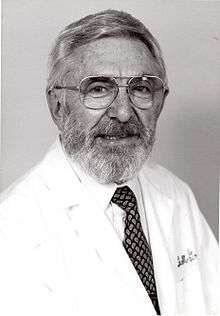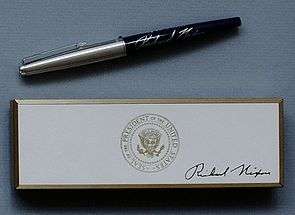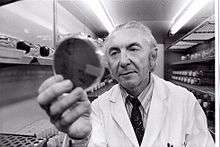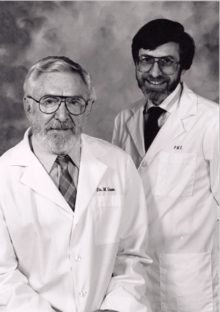Maurice Green (virologist)
| Maurice Green | |
|---|---|
 Maurice Green | |
| Born |
5 May 1926 New York, New York |
| Residence | St. Louis, Missouri |
| Nationality | American |
| Fields |
Virology Microbiology Biochemistry Molecular biology |
| Institutions | St. Louis University School of Medicine |
| Alma mater |
University of Wisconsin, Madison (M.S., Ph.D.) University of Michigan, Ann Arbor (B.S.) |
| Notable awards |
NIH R.E. Dyer Lectureship Award 1972 University of Chicago Howard Taylor Ricketts Award 1976 Burroughs-Wellcome Fellow (1986-1987) 1990 American Cancer Society John Krey III Memorial Award American Cancer Society (Heartland Division) Spirit of Health Award 2002 Academy of Science of St. Louis Peter H. Raven Lifetime Award |
| Spouse | Marilyn Glick Green (1929-2010; m. 1950) |
| Children |
Michael R. Green, M.D., Ph.D. Wendy A. Green Lee, M.D. Eric D. Green, M.D., Ph.D. |
|
Website http://medschool.slu.edu/mmi/index.php?page=maurice-green-ph-d | |
Maurice Green (born May 5, 1926) is an American virologist whose research career has spanned more than six decades.[1] He is regarded as a pioneer in the study of animal viruses, in particular their role in cancer.[1] Green founded the Institute of Molecular Virology[2][3][4] at St. Louis University School of Medicine in the late 1950s, and has since served as its Chairman.
Biography
Maurice Green was born on May 5, 1926 in New York, New York to Jewish parents, David Green, an immigrant from Russia, and Bessie Lipschitz, an immigrant from Lithuania. Green is the oldest of four children (younger sisters Claire, Muriel, and Sue).
Following graduation from high school in 1944, Green served in the U.S. Navy,[1] after which he earned a B.S. degree in Chemistry from the University of Michigan, Ann Arbor in 1949,[5] and then M.S. (1952) and Ph.D. (1954)[5] degrees in Biochemistry and Chemistry from the University of Wisconsin, Madison. He then pursued postdoctoral research training at the University of Pennsylvania School of Medicine, serving as an Instructor of Biochemistry from 1955-1956.
Green joined the faculty of St. Louis University School of Medicine as an Assistant Professor in the Department of Microbiology in 1956, being promoted to Associate Professor in 1960 and then Professor in 1963. In 1964, he became Professor of Molecular Virology and Founding Chairman of the Institute for Molecular Virology;[1][3][4][5] he has since held this title and position.[2]
Green is a well-known tumor virologists, with a research career that now spans over 60 years.[1] He played a critical role in developing adenovirus as an experimental system and made many important contributions in virology and molecular biology, leading to over 300 authored/co-authored publications[1] and one U.S. patent (No. 61/509,891).[6] He first coined the term “molecular virology” [1] (later founding an institute bearing that name). Many of his graduate students and postdoctoral fellows have gone on to successful research careers, making significant contributions to the fields of virology, molecular virology, and tumor biology.[1]


Green’s research in the 1960s and early 1970s was highly regarded because of the insights it provided into the role of viruses in cancer.[1][7][8][9][10][11][12] It is thus notable that in December 1971, Green was invited by U.S. President Richard Nixon to attend the signing of the National Cancer Act of 1971 at the White House, an event that is generally viewed as the beginning of the ‘War on Cancer.’ At that bill signing, he was given one of the pens used by President Nixon to sign the legislation.
Educational and professional honors given to Green have included: (1) multiple honorary societies (Phi Beta Kappa, Sigma Xi, Gamma Alpha, Phi Lambda Upsilon, and Phi Kappa Phi); (2) an NIH lifetime Research Career Award (1969–present);[1][5][13] (3) the NIH R.E. Dyer Lectureship Award (1972);[5][14] (4) the 1976 University of Chicago Howard Taylor Ricketts Award (1976)[5] (5) Burroughs-Wellcome Fellow (1986-1987); (6) the 1990 American Cancer Society John Krey III Memorial Award; (7) the 2002 American Cancer Society (Heartland Division) Spirit of Health Award; and (8) the 2002 Academy of Science of St. Louis Peter H. Raven Lifetime Award and Fellow.[1][5]
Green married Marilyn Glick (1929-2010) on August 20, 1950. They had three children: Michael R. Green, M.D., Ph.D.[15] (born January 20, 1954; a molecular and cancer biologist researcher, Howard Hughes Medical Institute Investigator, Director of the University of Massachusetts Medical School Cancer Center, Chairman of the University of Massachusetts Medical School Department of Molecular, Cell, and Cancer Biology, Member of the U.S. National Academy of Sciences, and Member of the U.S. National Academy of Medicine), Wendy A. Green Lee, M.D.[15] (born February 15, 1957; a pediatrician); and Eric D. Green, M.D., Ph.D. (born December 10, 1959; a pathologist and genomics researcher, a major participant in the Human Genome Project) currently Director of the National Human Genome Research Institute, National Institutes of Health.[14][15][16] Green has three granddaughters and two grandsons.
-

Green with his three children in March 1964 (from left to right: Eric Green, Wendy Green, and Michael Green).
-

Green with wife Marilyn Green and son Eric Green on September 23, 2008, at the Inaugural Maurice Green Lecture at St. Louis University School of Medicine. Eric Green (then Scientific Director of the National Human Genome Research Institute at the National Institutes of Health) was the Inaugural Maurice Green Lecturer, giving a presentation entitled “Fulfilling the Promise of a Sequenced Human Genome.”
-

Maurice Green with nobel laureate James Watson at the National Human Genome Research Institute Symposium celebrating the 10th anniversary of completing a draft sequence of the human genome. From left to right: Maurice Green, James Watson (Nobel Laureate; former Director of the National Human Genome Research Institute), grandson Joshua Green, and son Eric Green (Director, National Human Genome Research Institute).
Research
Maurice Green, Ph.D. is one of the founding scientists in the field of tumor virology,[1] an area of biomedical research investigating the role that viruses play in cancer.[17][18][19][20][21][22][23][24] His early studies were major contributions to the general armamentarium of techniques and concepts used in experimental virology today.

In the late 1950s and early 1960s, Green was among the first scientists in the world to study biochemical features of virus replication in cell culture and to develop and apply the emerging concepts of molecular biology.[1] His major focus of investigation was human adenoviruses. He and his colleagues worked out the basic parameters for working with these viruses – for example, how to grow them in culture, to purify the virions, to extract and characterize the viral DNA,[25] and to study gene expression at the RNA and protein levels.[26] This work established the kinetics of infection, and showed that the infection was divided into two major stages of gene expression.

In 1962, scientists at the National Institutes of Health discovered that certain serotypes of human adenoviruses can induce tumors in newborn hamsters.[1][27] This finding was not only of scientific interest, but it also raised concerns because the military was using live adenoviruses as vaccines against adenovirus-induced acute respiratory disease. Green was asked to learn as much as he could as quickly as possible about the 31 distinct viral serotypes known at that time.[4] His studies included characterizing the viruses’ DNA, investigating the tumor-inducing properties of the viruses, and determining the molecular and kinetic parameters of adenovirus infection. He showed that adenoviruses could be divided into distinct groups based on these and other properties. These classic studies served to establish adenoviruses as a powerful model system that has since been used to address more global questions about virus replication, human cell molecular biology, infection and immunity, and neoplastic transformation. In subsequent years, the study of adenoviruses has provided key insights into tumor suppressors, cell proliferation, and the host immune response. They also emerged as a vehicle for human gene therapy[28]
Also in the early 1960s, Green and others showed that human adenoviruses could transform rodent cells in culture into a malignant state.[1][8] The mechanism behind this phenomenon was a mystery at that time. In 1966, Green published a paper in the Proceedings of the National Academy of Sciences showing for the first time that transformed cells express adenovirus-specific RNA that could be labeled in a fashion that would allow detection based on hybridization to adenovirus DNA immobilized on filters.[26] This pioneering work helped establish the principle – applicable to all tumor viruses and relevant to tumor oncogenesis more broadly – that adenoviruses transform cells via continuous expression of their genes rather than by a ‘hit-and-run’ mechanism.
In subsequent years, Green made many other contributions to adenovirus molecular biology. He discovered two of the proteins required for adenoviruses to transform cells, and also other proteins that usurp the infected cell and convert it into a factory for virus replication. This later work played a key role in further establishing adenovirus as an experimental system, attracting other research groups and producing many important discoveries. For example, RNA splicing were discovered using the adenovirus system by researchers at the Cold Spring Harbor Laboratory and the Massachusetts Institute of Technology (work that led to a Nobel Prize in 1989 and 1993)[29][30]

In addition to determining many of the basic concepts of adenovirology, Green conducted seminal studies to determine the role that these viruses play in human cancer.[7][8][9][10][11][12] He demonstrated that although these viruses are endemic in the human population and have oncogenic potential in rodents, they appear to play no detectable part in the formation of any of the major human cancers.
Green studied not only adenoviruses but also many other tumor viruses. At the time, it was commonly hypothesized that inasmuch as tumor viruses cause certain cancers in animal species,[1][31][32] they might also cause cancers in humans. Green embarked on a large study to ask whether human cancers contain tumor virus genes. This study, funded by the National Institutes of Health via the Virus Cancer Program, was a major component of President Richard Nixon's ‘War on Cancer.’ Green collected over 2500 tumor samples and analyzed them for the presence of different DNA and RNA tumor viruses. Nearly all the samples were negative. These carefully controlled data, which were published in a series of papers, argued strongly against a viral etiology of human cancer. One exception was the detection of papillomavirus DNA in urogenital cancers; Green was probably the first to make this finding, although he was the second to publish it in the scientific literature.[33]
Later, Green’s research extended to the RNA tumor viruses (tumor inducing viruses with an RNA genome). Before reverse transcriptase was discovered by David Baltimore and Howard Temin in 1970 (work that earned them a Nobel Prize), Green wrote a review predicting that the enzyme must exist in the virion of retroviruses. In the early 1970s, he and his co-workers conducted important studies on the biochemical features of reverse transcriptases of avian and murine RNA tumor viruses. These studies revealed the subunit structure of the enzyme and helped define the polymerase and Ribonuclease H activities inherent with that enzyme.[34] He coupled this basic research to the effort to detect RNA tumor viruses in human cancer. Tremendous effort was directed to the ‘simultaneous detection’ assay in which proteins are extracted from tumor samples, separated by size, and then examined for reverse transcriptase activity. There was angst associated with those studies because of the importance of the research and because the workers could occasionally detect weak activity. As was later shown, this activity was not due to infection by RNA tumor viruses, but rather to endogenous reverse transcriptase activity.[35][36] These studies were negative, again arguing against a viral etiology of cancer.
In recent years, Green has focused his studies on the multifunctional adenovirus oncoprotein E1A,[1][14][37] which is necessary for cell transformation of adenovirus non-permissive cells. He was among the first to demonstrate that individual functional domains within E1A are independent,[38] an observation that has since been exploited by other laboratories studying a number of regulatory proteins. Most recently, Green has been focused on the 80-amino-acid E1A N-terminal transcriptional repression domain in order to understand the mechanism of gene control and regulation by this potent transcriptional repressor[39] he has also examined the potential application of repressing medically important genes by E1A’s transcriptional repression function[40]
In addition to his own research, Green is well known for founding, building, and leading the Institute for Molecular Virology[1][3][4][5] at the Saint Louis University School of Medicine. This internationally recognized institute and its research faculty was the site of numerous important studies on viruses, cancer, AIDS,[41][42][43][44][45] and contemporary molecular biology.
In summary, Green’s research has contributed to – and, in fact, greatly stimulated – the fields of virology and molecular biology. His contributions have and continue to illuminate fundamental aspects of virus biology, transcriptional regulation, and mechanisms of oncogenesis.
References
- 1 2 3 4 5 6 7 8 9 10 11 12 13 14 15 16 17 18 "Going Viral : Saint Louis University : SLU". www.slu.edu. Retrieved 2016-07-19.
- 1 2 "Maurice Green, Ph.D". Saint Louis University Faculty_IMV.
- 1 2 3 Adams, Leonard (February 27, 1966). "Cancer Research 'Dangerous'". The Pittsburgh Press. Retrieved July 17, 2016 – via Google News.
- 1 2 3 4 "Cancer Studies Progress in an Old Streetcar Barn". Reading Eagle. February 27, 1966. Retrieved July 17, 2016 – via Google News.
- 1 2 3 4 5 6 7 8 "University of Michigan Chemistry News Winter 2015" (PDF). University of Michigan Chemistry Department. 2015. p. 10. Retrieved July 17, 2016.
- ↑ "United States Patent Application: 0130023481". appft.uspto.gov. Retrieved 2016-07-17.
- 1 2 "Cancer Virus Trace Found". Spokane Daily Chronicle. April 5, 1967. Retrieved July 17, 2016 – via Google News.
- 1 2 3 Carey, Frank (April 6, 1967). "Possible Breakthrough in Determining If Some Cancers Caused by Virus". The Telegraph. Retrieved July 17, 2016 – via Google News.
- 1 2 Spaulding, Frank (April 5, 1967). "New Technique May Show Viruses' Role in Cancer". Park City Daily News. Retrieved July 17, 2016 – via Google News.
- 1 2 "New Break Is Seen For Cancer Job". Lawrence Journal-World. April 5, 1967. Retrieved July 17, 2016.
- 1 2 "Cancer 'Breakthrough' Claimed by Scientist". Ellensburg Daily Record. April 5, 1967. Retrieved July 17, 2016 – via Google News.
- 1 2 Spaulding, James (April 20, 1967). "Major Research Underway to Link Cancer to Virus". The Milwaukee Journal. Retrieved July 17, 2016 – via Google News.
- ↑ "A 44-year-old grant | The Scientist Magazine®". The Scientist. Retrieved 2016-07-17.
- 1 2 3 MacDougall, Raymond (October 3, 2008). "Biomedical Research: It's In the Greens". NIH Record. Retrieved July 17, 2016.
- 1 2 3 Powers, Ellia (November 5, 2010). "Genome research institute director is part of St. Louis' first family of science". Saint Louis Beacon. Retrieved July 17, 2016.
- ↑ "Ladue Alumnus, National Human Genome Research Institute Director Speaks with Students". Spotlight on Ladue Schools. Ladue Schools. September 18, 2015. Retrieved July 17, 2016.
- ↑ Baker, Carl (1975). An Administrative History of the National Cancer Institute’s Viruses and Cancer Programs. National Institutes of Health – via history.nih.gov.
- ↑ Kalland, Karl-Henning; Ke, Xi-Song; Øyan, Anne Margrete (2009-05-01). "Tumour virology--history, status and future challenges". APMIS: acta pathologica, microbiologica, et immunologica Scandinavica. 117 (5–6): 382–399. doi:10.1111/j.1600-0463.2009.02452.x. ISSN 1600-0463. PMID 19400863.
- ↑ Olson, James Stuart (1989). The History of Cancer: An Annotated Bibliography. ABC_CLIO. ISBN 0313258899.
- ↑ Kelly, Elizabeth; Russell, Stephen J. (2007-04-01). "History of oncolytic viruses: genesis to genetic engineering". Molecular Therapy: the Journal of the American Society of Gene Therapy. 15 (4): 651–659. doi:10.1038/sj.mt.6300108. ISSN 1525-0016. PMID 17299401.
- ↑ Morange, Michael (1997).From the Regulatory Vision of Cancer to the Oncogene Paradigm, 1975–1985. Journal of the History of Biology, 30(1). doi:10.1023/A:1004255309721
- ↑ Marcum, J. (2002). From Heresy to Dogma in Accounts of Opposition to Howard Temin's DNA Provirus Hypothesis. History and Philosophy of the Life Sciences, 24(2), 165-192. Retrieved from http://www.jstor.org/stable/23332384
- ↑ Richards, Victor (1978-01-01). Cancer: The Wayward Cell : Its Origins, Nature, and Treatment. University of California Press. ISBN 9780520035966.
- ↑ Doerfler, W. (2012-12-06). The Molecular Biology of Adenoviruses I: 30 Years of Adenovirus Research 1953–1983. Springer Science & Business Media. ISBN 9783642694608.
- ↑ Green, M.; Pina, M. (1963-07-01). "Similarity of DNAs isolated from tumor-inducing viruses of human and animal origin". Proceedings of the National Academy of Sciences of the United States of America. 50: 44–46. Bibcode:1963PNAS...50...44G. ISSN 0027-8424. PMC 300651
 . PMID 13950094.
. PMID 13950094. - 1 2 Green, Maurice; Fujinaga, K (1966). "The mechanism of viral carcinogenesis by DNA mammalian viruses: viral-specific RNA in polyribosomes of adenovirus tumor and transformed cells". Proceedings of the National Academy of Sciences. 55 (6): 1567–74. PMC 224360
 . PMID 5227675.
. PMID 5227675. - ↑ HUEBNER (1963). "Specific Adenovirus Complement-Fixing Antigens in Virus-Free Hamster and Rat Tumors". Proceedings from the National Academy of Sciences. 50: 379. Bibcode:1963PNAS...50..379H.
- ↑ Wold, William S. M.; Toth, Karoly (2013-12-01). "Adenovirus vectors for gene therapy, vaccination and cancer gene therapy". Current Gene Therapy. 13 (6): 421–433. ISSN 1875-5631. PMC 4507798
 . PMID 24279313.
. PMID 24279313. - ↑ "The Nobel Prize in Physiology or Medicine 1993". www.nobelprize.org. Retrieved 2016-05-22.
- ↑ "The Nobel Prize in Physiology or Medicine for 2001 - Press Release". www.nobelprize.org. Retrieved 2016-05-22.
- ↑ "Clocks and maps are needed in development". New Scientist. 1973. Retrieved July 17, 2016 – via Google Books.
- ↑ Gould, Donald (1964). "Hunting the leukaemia virus". New Scientist (412). pp. 89–91. Retrieved July 17, 2016 – via Google Books.
- ↑ Green, M., Brackmann, K. H., Sanders, P. R., Loewenstein, P. M., Freel, J. H., Eisinger, M., & Switlyk, S. A. (1982). Isolation of a human papillomavirus from a patient with epidermodysplasia verruciformis: Presence of related viral DNA genomes in human urogenital tumors. Proceedings of the National Academy of Sciences, 79(14), 4437-4441. doi:10.1073/pnas.79.14.4437
- ↑ Grandgenett, D. P., Gerard, G. F., & Green, M. (1973). A Single Subunit from Avian Myeloblastosis Virus with Both RNA-Directed DNA Polymerase and Ribonuclease H Activity. Proceedings of the National Academy of Sciences, 70(1), 230-234. doi:10.1073/pnas.70.1.230
- ↑ Gallo, Robert (1991). Virus Hunting: AIDS, Cancer, and the Human Retrovirus : a Story of Scientific Discovery. Basic Books. p. 75. ISBN 0465098150 – via Google Books.
- ↑ Chedd, Graham (1971). "RNA to DNA: a revolution in reverse". New Scientist. Retrieved July 17, 2016 – via Google Books.
- ↑ "Biochemistry of Viral Replication". 360 BIO. September 1, 1977. Retrieved July 17, 2016.
- ↑ Lillie, J. W., Loewenstein, P. M., Green, M. R., & Green, M. (1987). Functional domains of adenovirus type 5 E1a proteins. Cell, 50(7), 1091-1100. doi:10.1016/0092-8674(87)90175-9
- ↑ Loewenstein, P. M., Wu, S., Chiang, C., & Green, M. (2012). The adenovirus E1A N-terminal repression domain represses transcription from a chromatin template in vitro. Virology, 428
- ↑ Loewenstein, P. M., & Green, M. (2011). Expression of the Adenovirus Early Gene 1A Transcription-Repression Domain Alone Downregulates HER2 and Results in the Death of Human Breast Cancer Cells Upregulated for the HER2 Proto-Oncogene. Genes & Cancer, 2(7), 737-744. doi:10.1177/1947601911426570
- ↑ "St. Louis researchers uncover key scientific discoveries about AIDS". The Southeast Missourian. December 25, 1988. Retrieved July 17, 2016 – via Google News.
- ↑ Haney, Daniel (July 14, 1989). "Mutant Proteins could be cure for AIDS". Spokane Chronicle. Retrieved July 17, 2016 – via Google News.
- ↑ Haney, Daniel (July 14, 1989). "Proteins may halt the spread of AIDS". The Telegraph. Retrieved July 17, 2016 – via Google News.
- ↑ "Discovery may stop the AIDS virus". New Straits Times. July 15, 1989. Retrieved July 17, 2016 – via Google News.
- ↑ Hanely, Daniel (July 14, 1989). "Fake Proteins Can Jam AID Virus, Docs Say". Schenectady Gazette. Retrieved July 17, 2016 – via Google News.